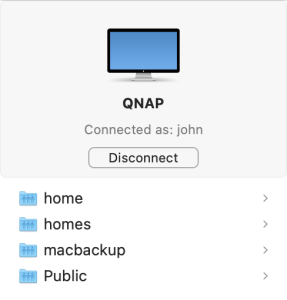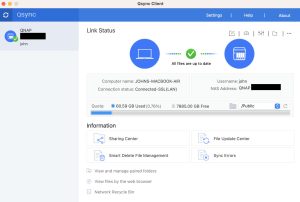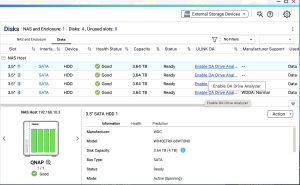QNAP NAS Review TS-433-4G-US
I’ve never bought an off the shelf NAS before and have always opted to build them on my own. There is no better resource for NAS building than this website. I currently have two home brew NAS’s in operation but had a need for a 2.5 GB NAS for a new, faster network I was setting up. I settled on a QNAP NAS for a couple of reasons.
Reason number 1 was that initially my 2.5 GB network was only going to be in the downstairs part of my home. Reason 2 is because since it was downstairs it needed to be somewhat attractive to appease my wife, and something somewhat quieter than my home brew NAS builds.

QNAP NAS
After a considerable amount of research I opted to get the QNAP TS-433-4G-US.($379)
4 bays is enough for me I have four 4TB Western Digital Red drives in a RAID 5 array.
This NAS is simply for file storage and I won’t be asking it to run any media servers or anything else that might overtask it.
I have a super NAS upstairs with a Xeon processor and tons of RAM and storage with Unraid as the OS. It does all that heavy lifting.
I do use the QNAP for Apple Time Machine backups for several Macs I have in the house.
I also run another server which is located in my back yard shed which is a Raspberry Pi Compute Module 4 with a SATA PCIe controller and a couple of 6TB hard drives. It runs OpenMediaVault (OMV).
This will NOT be a technical review. No specs, no stats. Just me talking about whether buying a NAS off the shelf is something a NAS user would want to do or not.
Reasons For Buying
As I mentioned I needed something relatively attractive for wife acceptance factor, and something reasonably quiet. Hot swappable drive bays with no tools required to change a disk was a huge consideration as well. Additionally, the ability to upgrade RAM was a factor as was the fact that it had a 2.5GB ethernet port. Again, I could have built a NAS but this time it just made sense to buy one off the shelf.
OS Comparison
After years of building NAS’s and trying various OS’s I was nervous about trying something proprietary like QTS. I’m an Open Source kind of guy.
For years I ran FreeNAS which is now TrueNAS and that is probably my favorite NAS OS. Unraid is pretty cool and a bit easier to configure docker containers. OpenmediaVault is Linux and while I run it on a Raspberry Pi NAS it’s kind of overkill. I should have just installed Ubuntu Server and set up Samba File Sharing, because that’s all I use it for. One of the reasons I use a Pi for this server is because my shed is a wood shop. The dust situation is awful. I’d rather blow up a Pi, IO Board, and inexpensive SATA controller than an expensive NAS with a bunch of expensive disks in it.
I wasn’t sure I’d be able to cope with QNAP QTS but so far it isn’t too bad. It has a nice looking GUI but I don’t spend much time in there.

QTS
I’m kind of in “set and forget” mode. It appears in my Network as an SMB server. That makes it easy to drop and drag or find files quickly.

Mac SMB
I also configured it as an Apple Time Machine backup server which is also kind of “set and forget”.
Sync Client
One of the joys of having a NAS is figuring out how to sync your files to your NAS. I’ve tried everything there is to try such as 3rd party apps or RSYNC commands from the Mac. QNAP has an app called QSync. I personally think that Qsync is bit buggy and sometimes crashes on me.
Typically I don’t leave Qsync turned on but maybe once a week or so I’ll launch it and let it sync all the folders I have set up to synchronize. Or maybe if I do a lot of downloads or something I’ll run Qsync on an as needed basis.

Qsync Client
If it doesn’t do something buggy it generally works good and pretty darn fast.
Disk Repair
Recently my Disk 4 reported itself as having bad sectors beyond the manufacturers recommendations. Having a RAID 5 array meant I could just hot swap the disk. It took about 16 hours to rebuild the Data Volume however it is back to normal operation following the rebuild. 4 green lights is a pretty sight.

Disk Status
Final Thoughts
If you need a NAS I really recommend just building one yourself. Sadly that can get pretty expensive, pretty quick. But if you want speed and power to run media servers and a dozen other home lab tasks then you really need to DIY your own file server.
I never thought I’d see the day where I’d buy a commercial NAS off the shelf but the stars lined up to where it actually made sense for me to do that.
If you do buy off the shelf make sure there is some upgradability to your NAS otherwise it will become outdated fast. Firmware and OS updates will eventually start consuming more and more RAM and if you can’t upgrade, you’ll outgrow your device in a couple years.
I am curious how many years they will support this NAS for updates and security patches. I always recommend that everyone should have a hardware firewall appliance, but alas, almost no one I know except me does.
If you can’t build a NAS then I can recommend this particular QNAP NAS but I don’t think it is as powerful or flexible as making your own.

Hi John.
Thanks for the article. You are absolutely right but I tried so many times and never reached completion. Always got stuck in the configuration process. Would please guide to a simple way to DIY NAS. You won’t believe that I have been trying for the last 3/4 years but never accomplished. Thanks again